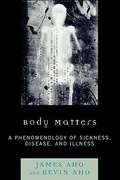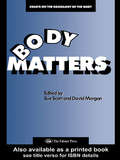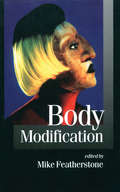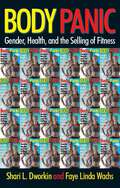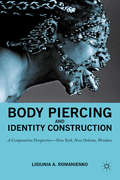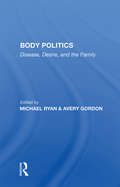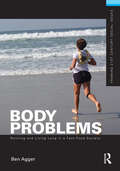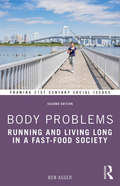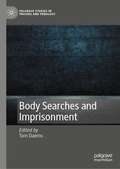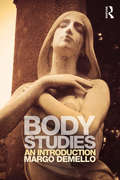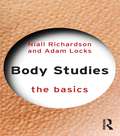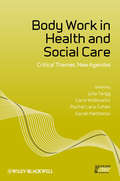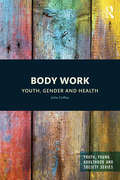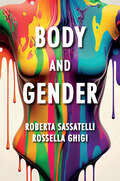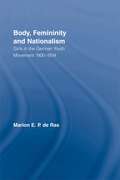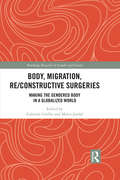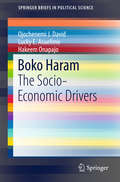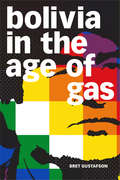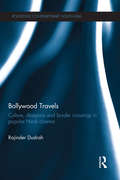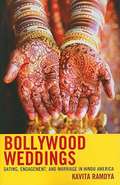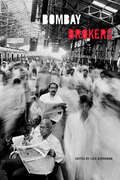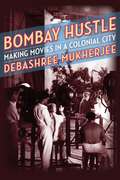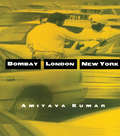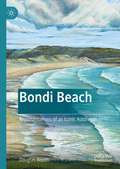- Table View
- List View
Body Matters: A Phenomenology of Sickness, Disease, and Illness
by James AhoFollowing the core principle of phenomenology as a return 'to the things themselves,' Body Matters attends to the phenomena of bodily afflictions and examines them from three different standpoints: from society in general that interprets them as 'sicknesses,' from the medical professions that interpret them as 'diseases,' and from the patients themselves who interpret them as 'illnesses.' By drawing on a crucial distinction in German phenomenology between two senses of the body_the quantifiable, material body (Ksrper) and the lived-body(Leib)_the authors explore the ways in which sickness, disease, and illness are socially and historically experienced and constructed. To make their case, they draw on examples from a multiplicity of disciplines and cultures as well as a number of cases from Euro-American history. The intent is to unsettle taken-for-granted assumptions that readers may have about body troubles. These are assumptions widely held as well by medical and allied health professionals, in addition to many sociologists and philosophers of health and illness. To this end, Body Matters does not simply deconstruct prejudices of mainstream biomedicine; it also constructively envisions more humane and artful forms of therapy.
Body Matters: Essays On The Sociology Of The Body
by David Morgan Sue ScottFocusing on the sociological embodiment of various "social actors", the authors consider the subsequent links with the constraints of daily life i.e. the male body, female therapists, body builders, marital and sexual counsellors, sex workers. They present recent or new research findings on aspects of the body, variants from what is conventionally seen as "natural" and consider and question aspects of self-image versus society's expectations. A number of developments in discussions of the body on such topics as feminist thought, the study of health and illness and cultural theory are presented as a series of essays which demonstrate the variety of interests mentioned.; The book is aimed at undergraduates/postgraduates students and lecturers in sociology, cultural studies, women's and gender studies.
Body Modification (Published in association with Theory, Culture & Society)
by Mike FeatherstoneThis fascinating collection explores the growing range of body modification practices such as piercing, tattooing, branding, cutting and inserting implants, which have sprung up recently in the West. It asks whether this implies that we are returning to traditional tribal practices of inscribing identities onto bodies on the part of ′modern primitives′, or is body modification better understood as purely cosmetic and decorative with body markings merely temporary signs of transferable loyalties?
Body Panic: Gender, Health, and the Selling of Fitness
by Faye Linda Wachs Shari L. DworkinDworkin and Wachs analyze 10 years of health and fitness magazines to uncover how bodies are made in popular cultureAre you ripped? Do you need to work on your abs? Do you know your ideal body weight? Your body fat index? Increasingly, Americans are being sold on a fitness ideal—not just thin but toned, not just muscular but cut—that is harder and harder to reach. In Body Panic, Shari L. Dworkin and Faye Linda Wachs ask why. How did these particular body types come to be “fit”? And how is it that having an unfit, or “bad,” body gets conflated with being an unfit, or “bad,” citizen?Dworkin and Wachs head to the newsstand for this study, examining ten years worth of men’s and women’s health and fitness magazines to determine the ways in which bodies are “made” in today’s culture. They dissect the images, the workouts, and the ideology being sold, as well as the contemporary links among health, morality, citizenship, and identity that can be read on these pages. While women and body image are often studied together, Body Panic considers both women’s and men’s bodies side-by-side and over time in order to offer a more in-depth understanding of this pervasive cultural trend.
Body Piercing and Identity Construction: A Comparative Perspective — New York, New Orleans, Wroc?aw
by Lisiunia A. RomanienkoBased on a fifteen year longitudinal cross-cultural analysis on the role of the body in identity construction process around the world, this analysis provides readers with a comparative theoretical exploration of piercing and other forms of body modification that international communities of defiance use to express their identity.
Body Politics: Disease, Desire, And The Family
by Michael RyanThis book looks at the physical and metaphorical attributes of the human body as a site of contention, politics, and cultural protest. It discusses a range of issues, from torture and moral panics to the "AIDS plague" and the homosocial subtexts of George Bush's political speeches.
Body Problems: Running and Living Long in a Fast-Food Society
by Ben AggerThis book addresses the relationship between the body and society in a fast-food society. Agger focuses on issues of food, exercise, work, dieting and eating disorders, fashion, bariatric and cosmetic surgery, and health. He addresses the dilemma that we have ample access to abundant calories but lead lifestyles and have jobs that for the most part do not enable us to expend those calories. He proposes solutions, both individual and structural, that involve re-orienting ourselves to exercise as play. The book can be used in introductory sociology, social problems, work, sociology of sport, gender, health and illness. The goal of this new, unique Series is to offer readable, teachable "thinking frames" on today’s social problems and social issues by leading scholars, all in short 60 page or shorter formats, and available for view on http://routledge.customgateway.com/routledge-social-issues.html For instructors teaching a wide range of courses in the social sciences, the Routledge Social Issues Collection now offers the best of both worlds: originally written short texts that provide "overviews" to important social issues as well as teachable excerpts from larger works previously published by Routledge and other presses.
Body Problems: Running and Living Long in a Fast-Food Society (Framing 21st Century Social Issues)
by Ben AggerThis much expanded new edition explores the relationship between the body and society in a fast-food society. Agger focuses on issues of food, exercise, work, dieting, eating disorders, fashion, bariatric and cosmetic surgery, and health. The new edition updates examples and statistics throughout and it offers three timely chapters that did not appear previously. Agger addresses the dilemma that we have ample access to abundant calories but lead lifestyles and have jobs that for the most part do not enable us to expend those calories. He proposes solutions, both individual and structural, that involve re-orienting ourselves to exercise as play. The book is ideal for courses in introductory sociology, social problems, work, sociology of sport/leisure, gender, and health and illness.
Body Searches and Imprisonment (Palgrave Studies in Prisons and Penology)
by Tom DaemsThis book explores and addresses body search practices in prison environments from different angles (criminology, sociology, human rights and law) and discusses such practices in different national contexts within Europe. Body searches are widely used in prison systems across the globe: they are perceived as indispensable to prevent forbidden substances, weapons or communication devices from entering the prison. However, these are also invasive and potentially degrading control techniques. It should not come as a surprise, then, that body searches are deeply contested security measures and that they have been widely debated and regulated. What makes theses control measures problematic in a prison context? How do these practices come to be regulated in an international and European context? How are rules translated into national law? To what extent are laws and rules respected, bent, circumvented and denied? And what does the future hold for body searches?
Body Studies: An Introduction
by Margo DeMelloIn recent years, body studies has expanded rapidly, becoming an increasingly popular field of study within anthropology, sociology, and cultural studies. This groundbreaking textbook takes the topics and theories from these disciplines, and combines them into one single, easily accessible text for students. Body Studies is a comprehensive textbook on the social and cultural uses and meanings of the body, for use in undergraduate college courses. Its clear, accessible chapters explore, among other things: the measurement and classification of the human body illness and healing the racialized body the gendered body cultural perceptions of beauty new bodily technologies. This book investigates how power plays an important role in the uses, views, and shapes of the body—as well as how the body is invested with meaning. Body Studies provides a wealth of pedagogic features for ease of teaching and learning: ethnographic case studies, boxes covering contemporary controversies, news stories, and legislative issues, as well as chapter summaries, further reading recommendations, and key terms. This book will appeal to students and teachers of sociology, anthropology, cultural studies, women’s studies, gender studies, and ethnic studies.
Body Studies: The Basics (The Basics)
by Niall Richardson Adam LocksConsideration of the body as a subject for study has increased in recent years with new technologies, forms of modification, debates about obesity and issues of age being brought into focus by the media. Drawing on contemporary culture, Body Studies: The Basics introduces readers to the key concerns and debates surrounding the study of the sociological body, cutting across disciplines to cover topics which include: Nature vs. Culture: how we ‘build’ and transform our bodies Conformity and resistance in bodily practice Issues of body image – beauty, diet, exercise and age Sporting bodies and the pursuit of ideals Enfreakment, disability and monstrosity Cyborgs and virtual online bodies With further reading signposted throughout, this accessible book is essential reading for anyone studying the body through the lens of sociology, cultural studies, sports studies, media studies and gender studies; and all those with an interest in how the physical body can be a social construct.
Body Work in Health and Social Care: Critical Themes, New Agendas (Sociology of Health and Illness Monographs #14)
by Carol Wolkowitz Sarah Nettleton Julia Twigg Rachel Lara CohenThe first book to fully explore the multiple ways in which body work features in health and social care and the meanings of this work both for those employed to do it and those on whose bodies they work. Explores the commonalities between different sectors of work, including those outside health and social care Contributions come from an international range of experts Draws on perspectives from across the medical, therapeutic, and care fields Incorporates a variety of methodological approaches, from life history analysis to ethnographic studies and first person accounts
Body Work: Youth, Gender and Health (Youth, Young Adulthood and Society)
by Julia CoffeyThe rise of the health, beauty and fitness industries in recent years has led to an increased focus on the body. Body image, gender and health are issues of long-standing concern in sociology and in youth studies, but a theoretical and empirical focus on the body has been largely missing from this field. This book explores young people’s understandings of their bodies in the context of gender and health ideals, consumer culture, individualisation and image. Body Work examines the body in youth studies. It explores paradoxical aspects of gendered body work practices, highlighting the contradiction in men’s increased participation in these industries as consumers alongside the re-emphasis of their gendered difference. It explores the key ways in which the ideal body is currently achieved, via muscularising practices, slimming regimes and cosmetic procedures. Coffey investigates the concept of ‘health’ and how it is inextricably linked both to the bodily performance of gender ideals and an increased public emphasis on individual management and responsibility in the pursuit of a ‘healthy’ body. This book’s conceptual framework places it at the forefront of theoretical work concerning bodies, affect and images, particularly in its development of Deleuzian research. It will appeal to a wide range of scholars and students in fields of youth studies, education, sociology, gender studies, cultural studies, affect and body studies.
Body and Gender: Sociological Perspectives
by Roberta Sassatelli Rossella GhigiEven though we often think of bodies as natural and given, or else as freely plastic objects, bodies are both constructed and fundamental to our sense of self. This book investigates the body as an essential vector of inequality, shaped by institutions, interaction and culture, and how in turn it contributes to partly modify them. Sassatelli and Ghigi show how the process of embodiment is at the same time naturalized and contested, particularly evident in the case of gender. Drawing on classical sociological research about modernity and contemporary studies that emphasize intersectionality, the book looks at how the gendered body has been conceptualized with special attention to body politics, the power of appearance and the representation of embodied identity. It also considers the interplay between body, sex and sexuality and the way gendered bodies intersect with other dimensions of social inequality such as race, age, class and disability. This exploration of the rich field of sociological inquiry into the gendered body will be an invaluable read for all seeking to understand gender, sexuality and embodiment in contemporary society.
Body, Femininity and Nationalism: Girls in the German Youth Movement 1900–1934 (Routledge Research in Gender and Society #Vol. 6)
by Marion E.P. de RasThis social and cultural history of girls in the German youth movements in the pre-Nazi era brings fascinating new light to bear on the history of the German youth movements. It contributes to our wider understanding of girlhood in the period, and investigates how mentalities, collective identities and German nationalism developed in the three decades before the Nazi period.
Body, Migration, Re/constructive Surgeries: Making the Gendered Body in a Globalized World (Routledge Research in Gender and Society)
by Gabriele Griffin Malin JordalBringing together an international range of case studies and interviews with individuals who have had genital re/construction, Body, Migration, Re/constructive Surgeries explores the socio-cultural meanings of clitoral re/construction following female genital cutting (FGC), hymen reconstruction, trans and intersex bodily interventions; and cosmetic surgery. Drawing critical attention to how decisions around such surgeries are affected by social, economic and regulatory contexts that change over time and across spaces, it raises questions such as: How are bodies genderized through surgical interventions? How do such interventions express cultural context? How do women who have experienced female genital cutting respond to opportunities for clitoral reconstruction? How do female-to-male (FtM) trans people decide on how and where to undertake body modifications? What roles do cultural expectations and official regulations play in how people decide to have their bodies modified? Suggesting that conventional gender binaries are no longer adequate to understanding the quest for bodily interventions, this insightful volume seeks to give a greater voice to those engaged in gender body modification. It will appeal to students and postdoctoral researchers interested in fields such as Gender Studies, Social Studies, Sexuality Studies and Cultural Studies.
Boiling Point: Republicans, Democrats, and the Decline of Middle-Class Prosperity
by Kevin PhillipsThe author of The Politics of Rich and Poor documents the economic frustration of the middle class, arguing that the middle class has been systematically undermined and fragmented by the Reagan-Bush economic policies.
Boko Haram: The Socio-Economic Drivers (SpringerBriefs in Political Science)
by Lucky E. Asuelime Ojochenemi J. David Hakeem OnapajoThis book investigates the socio-economic determinants of the emergence and persistence of Boko Haram terrorism in Nigeria. Since 2009, Boko Haram continues to capture mainstream news headlines, as well as the imagination of aspiring young Salafi-jihadists around the world who support the notion of a radical Islamist socio-political system. By providing an essential overview of the literature on Boko Haram and bridging research and current events, the authors cover a broad spectrum of topics and suggest relevant policies for addressing the problem of Boko Haram terrorism. While Boko Haram's motivations are ostensibly religious, the primary focus is on socio-economic inequality as one of the main factors that predispose the disillusioned, poverty-driven and jobless populace in the northern regions of Nigeria to take up arms against the state. The insights presented in this book will help researchers and policy-makers alike to understand the emergence of locally focused terrorist groups and insurgencies.
Bolivia in the Age of Gas
by Bret GustafsonEvo Morales, Bolivia's first Indigenous president, won reelection three times on a leftist platform championing Indigenous rights, anti-imperialism, and Bolivian control over the country's natural gas reserves. In Bolivia in the Age of Gas, Bret Gustafson explores how the struggle over natural gas has reshaped Bolivia, along with the rise, and ultimate fall, of the country's first Indigenous-led government. Rethinking current events against the backdrop of a longer history of oil and gas politics and military intervention, Gustafson shows how natural gas wealth brought a measure of economic independence and redistribution, yet also reproduced political and economic relationships that contradicted popular and Indigenous aspirations for radical change. Though grounded in the unique complexities of Bolivia, the volume argues that fossil-fuel political economies worldwide are central to the reproduction of militarism and racial capitalism and suggests that progressive change demands moving beyond fossil-fuel dependence and the social and ecological ills that come with it.
Bollywood Travels: Culture, Diaspora and Border Crossings in Popular Hindi Cinema (Routledge Contemporary South Asia Series)
by Rajinder DudrahUsing an interdisciplinary framework, this book offers a fresh perspective on the issues of diaspora culture and border crossings in the films, popular cultures, and media and entertainment industries from the popular Hindi cinema of India. It analyses and discusses a range of key contemporary films in detail, such as Veer Zaara, Jhoom Barabar Jhoom, and Dostana. The book uses the notion of travel analytically in and through the cinema to comment on films that have dealt with Indo-Pak border crossings, representations of diaspora, and gender and sexuality in new ways. It engages with common sense assumptions about everyday South Asian and diasporic South Asian cultures and representations as expressed in Bollywood cinema in order to look at these issues further. Moving towards an innovative exploration beyond the films, this book charts the circuits and routes of Bollywood as South Asian club cultures in the diaspora, and Hindi cinema entertainment shows around the world, as well as its impact on social media websites. Bollywood Travels is an original and thought provoking contribution to studies on Asian Culture and Society, Sociology, World Cinema, and Film, Media and Cultural Studies.
Bollywood Weddings: Dating, Engagement, and Marriage in Hindu America
by Kavita RamdyaBollywood Weddings examines how second-generation Indian-American Hindus of the middle and upper classes negotiate courtship and wedding rituals. Kavita Ramdya integrates the stories of twenty couples, showing the ways and means by which a subcommunity falls in love and expresses their identity. She provides readers with a window into these Indian-American couples who are navigating identities through a major rite of passage in their lives-marriage. She affirms that this community flaunts all things Indian as a way to assert their American identity. Many of these couples are occasional Hindus, displaying their Hindu religious background only on important occasions. Instead of choosing either India or America, or arriving at a compromise between the two, this community embraces both cultures simultaneously.
Bombay Brokers
by Lisa BjörkmanA political party worker who produces crowds for electoral rallies. A “prison specialist” who serves other people’s prison sentences in exchange for a large fee. An engineer who is able to secure otherwise impossible building permits. These and other dealmakers—whose expertise and labor are often considered morally suspect—can be indispensable for navigating everyday life in Bombay, one of the world’s most complex, dynamic, and populous cities. Bombay Brokers collects profiles of thirty-six such “brokers.” Written by anthropologists, artists, city planners, and activists, these character sketches bring into relief the paradox that these brokers’ knowledge and labor are ethically fraught yet essential for Bombay’s functioning. Their centrality reveals the global-scale paradoxes and gaps that these brokers mediate and bridge. In this way, Bombay Brokers prompts a reconsideration of what counts as legitimate and valuable knowledge and labor while offering insight into changing structures of power in Bombay and around the globe.Contributors. Anjali Arondekar, Sarthak Bagchi, Tobias Baitsch, Sangeeta Banerji, Srimati Basu, Tarini Bedi, Amita Bhide, Lisa Björkman, Uday Chandra, Simon Chauchard, Ka-Kin Cheuk, Michael Collins, Daisy Deomampo, Maura Finkelstein, Ajay Gandhi, Rupali Gupte, Kathryn C. Hardy, Lalitha Kamath, Prasad Khanolkar, Bhushan Korgaonkar, Ratoola Kundu, Ken Kuroda, Annelies Kusters, Lisa Mitchell, Shailaja Paik, Gautam Pemmaraju, Lubaina Rangwala, Llerena Guiu Searle, Atreyee Sen, Prasad Shetty, Rohan Shivkumar, Edward Simpson, David Strohl, Rachel Sturman, R. Swaminathan, Aneri Taskar, Yaffa Truelove, Sahana Udupa, Lalit Vachani, Leilah Vevaina
Bombay Hustle: Making Movies in a Colonial City (Film and Culture Series)
by Debashree MukherjeeFrom starry-eyed fans with dreams of fame to cotton entrepreneurs turned movie moguls, the Bombay film industry has historically energized a range of practices and practitioners, playing a crucial and compelling role in the life of modern India. Bombay Hustle presents an ambitious history of Indian cinema as a history of material practice, bringing new insights to studies of media, modernity, and the late colonial city.Drawing on original archival research and an innovative transdisciplinary approach, Debashree Mukherjee offers a panoramic portrait of the consolidation of the Bombay film industry during the talkie transition of the 1920s–1940s. In the decades leading up to independence in 1947, Bombay became synonymous with marketplace thrills, industrial strikes, and modernist experimentation. Its burgeoning film industry embodied Bombay’s spirit of “hustle,” gathering together and spewing out the many different energies and emotions that characterized the city. Bombay Hustle examines diverse sites of film production—finance, pre-production paperwork, casting, screenwriting, acting, stunts—to show how speculative excitement jostled against desires for scientific management in an industry premised on the struggle between contingency and control. Mukherjee develops the concept of a “cine-ecology” in order to examine the bodies, technologies, and environments that collectively shaped the production and circulation of cinematic meaning in this time. The book thus brings into view a range of marginalized film workers, their labor and experiences; forgotten film studios, their technical practices and aesthetic visions; and overlooked connections among media practices, geographical particularities, and historical exigencies.
Bombay--London--New York (Routledge Studies in Health and Social Welfare)
by Amitava KumarFirst published in 2003. Routledge is an imprint of Taylor & Francis, an informa company.
Bondi Beach: Representations of an Iconic Australian
by Douglas BoothBondi Beach is a history of an iconic place. It is a big history of geological origins, management by Aboriginal people, environmental despoliation by white Australians, and the formation of beach cultures. It is also a local history of the name Bondi, the origins of the Big Rock at Ben Buckler, the motives of early land holders, the tragedy known as Black Sunday, the hostilities between lifesavers and surfers, and the hullabaloos around the Pavilion. Pointing to a myriad of representations, author Douglas Booth shows that there is little agreement about the meaning of Bondi. Booth resolves these representations with a fresh narrative that presents the beach’s perspective of a place under siege. Booth’s creative narrative conveys important lessons about our engagement with the physical world.
